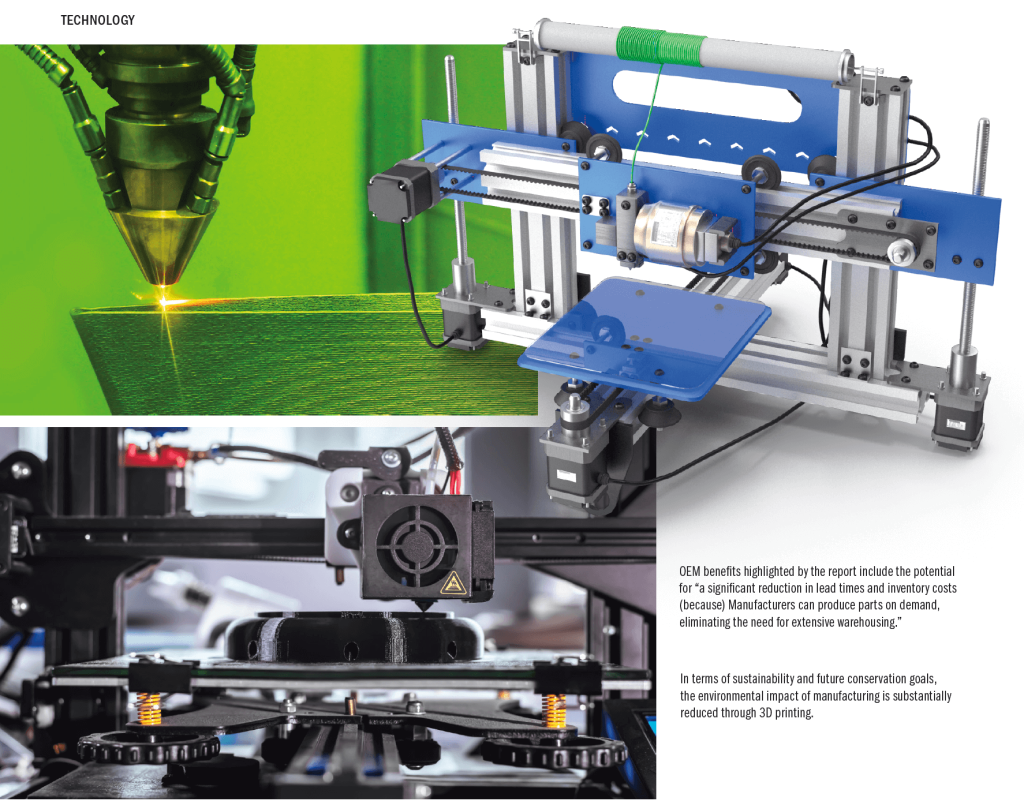
The 3D in Auto Repair Task Force: Harold Sears, Jason Moseley, Mario Dimovski, Francois Minec, Daniel Wittek, Rebecca Fecteau, Dallas Martin, Steve Fletcher, Dave Hartman, Jeff Peevy, AJ Strandquist, Justin Elliot and Darren Bright.
FROM PIXELS TO PAVEMENT
EXPLORING THE FUTURE OF 3D PRINTING IN THE AUTOMOTIVE INDUSTRY
By Sarah Perkins
Additive manufacturing, also known as 3D printing, has become an increasingly viable tool within the automotive industry as a strategy for efficiency and ease in manufacturing. According to a recent report made by the Task Force group, “the integration of 3D printing into the collision repair industry presents exciting possibilities that can revolutionize vehicle restoration.”
Made up of prominent entities such as IBIS Global, HP’s Barcelona Facility, Thatcham Research, ADAC Automotive, Carhart Products, Boyd Group and I-CAR, the Task Force group’s report focused on “engaging with industry stakeholders [to conduct] research on 3D printing applications” as well as “identifying key areas for improvement.”
Of specific focus was the potential benefits for different levels of the industry as well as the rising concern of the “risks associated with using poor quality 3D printed auto parts.”
In terms of the possible benefits of integrating 3D technologies, the report identifies that additive manufacturing offers OEMs several advantages. These include the capacity to produce complex geometric and intricate designs with expediated ease as well as the ability to help enhance performance while also reducing the overall weight and fuel efficiency for vehicles.
With the rise of EV technology and an environmental push to reduce the overall carbon footprint of the automotive industry, having the ability to improve fuel efficiency and vehicle weight helps contribute to these future goals.
Moreover, in terms of sustainability and future conservation goals, the environmental impact of manufacturing is substantially reduced through 3D printing. The technology minimizes material waste by utilizing only the necessary amounts of raw materials and recycling excess material, also reducing the logistics footprint. There is also the ability to “salvage parts that were once discarded due to missing or damaged plastic components” and this “empowers vehicle salvage and parts recyclers to diversify their offerings and to contribute to a more sustainable automotive supply chain.”
Other OEM benefits highlighted by the report include the potential for “a significant reduction in lead times and inventory costs [because] manufacturers can produce parts on demand, eliminating the need for extensive warehousing.”
When it comes to the production of smaller short-run plastic components, the report also found that the use of 3D printing was more efficient for production when compared to traditional large-volume injection molding manufacturing.
Specifically, smaller short-run plastic components would include the production of repair kits for headlights, sensor cradles for bumper covers, and high-value clips. 3D printing could also be viable to produce discontinued or out-of-stock-parts.
The report further highlighted potential benefits for automotive insurance companies by providing the opportunity for “reduced claim payouts, expedited settlements and heightened customer satisfaction” through the result of quicker repairs and cycle times.
In order to facilitate some of these benefits, the report documents the possibility of how “these innovative solutions could be distributed through an OEM or aftermarket supply model”
which would provide the opportunity to “enhance aftermarket offerings and align supply channels and repair parts with OEM standards in certain models.”
In turn, this could “potentially pave the way for in-house desk-top printers in larger collision centres or those that support a huband- spoke model.”
However, despite these potential pro’s, the Task Force group also outlines a series of challenges that could potentially harm the future growth of 3D printing in the automotive industry.
Of primary concern for the Task Force Group is the “influx of substandard, unregulated parts from unverified or unlicensed sources attempting to capitalize on 3D printing” channels.
Specifically, this concern arises as a result of “some people with low-end ‘hobbyist-grade’ printers and materials [thinking] they can use parts from these printers as replacement parts on vehicles.”
This mindset can thus result in specific instances where entry-level polypropylene materials are used as well as low-grade glue tabs which can result in the breakage of vehicle parts.

The report outlines one instance in which an unnamed USA-based MSO used 3D printing to make replacement vehicle parts but provided no information regarding the types of materials or printers used. When further investigated by the Task Force group, the report found that “this MSO was not an isolated case, and another overseas-based MSO is also using similar lower-grade materials and printers to repair prestige headlights.”
Ultimately, for the Task Force group, “the short-term uncertainties outweigh the potential opportunities, especially when it comes to ensuring that end parts meet a yet-to-beestablished standard for vehicle repairs.”
The primary risks that can come from using low-grade 3D printed parts include safety concerns regarding structural weakness; incompatibility and ill-fitting parts that reduce vehicle functionality; reduced longevity in vehicle parts; warranty and insurance violations potentially resulting in higher costs for the owner; and legal liabilities for OEMs and collision repair centres in the event of an accident or failures caused by poor parts. For OEMs and collision repair centres specifically, there is also the risk of reputation loss as faulty parts would decrease consumer confidence in these businesses’ ability to produce vehicles and make successful repairs. There is also continued risk to legitimate and recognized 3D printing providers such as the creation of market confusion, price pressures and difficulties maintaining reputation. On this note, the Task Force offers possible future solutions to protect the legitimacy of automotive 3D printing.
The group suggests recommendations such as creating a regulatory body “responsible for overseeing the use of 3D-printed auto parts.” Other suggestions include developing industry-wide quality standards and validation protocols for 3D printed parts; creating certification programs for 3D printing materials; implementing a rigorous material testing process; encouraging OEM and 3D printing provider collaborations; creating education opportunities; and enforcing penalties for non-compliance.
Overall, while there is still room for continued growth when it comes to the future development of 3D printing procedures, the Task Force group feels that despite developing difficulties, 3D printing has a bright future in automotive manufacturing and repair. If frameworks can be fashioned, then the industry can successfully “harness the benefits of 3D printing while ensuring the highest standards of safety, quality, and reliability.”


















